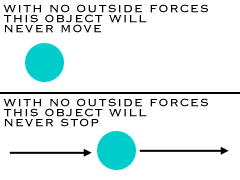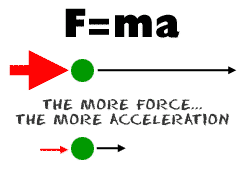There was this fellow in England named Sir Isaac Newton. A little bit stuffy, bad hair, but quite an intelligent guy. He worked on developingcalculus and physics at the same time. During his work, he came up with the three basic ideas that are applied to the physics of most motion (NOTmodern physics). The ideas have been tested and verified so many times over the years, that scientists now call them Newton's Three Laws of Motion.
First Law
 The first law says that an object at resttends to stay at rest, and an object inmotion tends to stay in motion, with the same direction and speed. Motion (or lack of motion) cannot change without an unbalanced force acting. If nothing is happening to you, and nothing does happen, you will never go anywhere. If you're going in a specific direction, unless something happens to you, you will always go in that direction. Forever.
The first law says that an object at resttends to stay at rest, and an object inmotion tends to stay in motion, with the same direction and speed. Motion (or lack of motion) cannot change without an unbalanced force acting. If nothing is happening to you, and nothing does happen, you will never go anywhere. If you're going in a specific direction, unless something happens to you, you will always go in that direction. Forever. You can see good examples of this idea when you see video footage ofastronauts. Have you ever noticed that their tools float? They can just place them in space and they stay in one place. There is no interfering force to cause this situation to change. The same is true when they throw objects for the camera. Those objects move in a straight line. If they threw something when doing a spacewalk, that object would continue moving in the same direction and with the same speed unless interfered with; for example, if a planet's gravity pulled on it (Note: This is a really really simple way of descibing a big idea. You will learn all the real details - and math - when you start taking more advanced classes in physics.).
Second Law
 The second law says that theacceleration of an object produced by a net (total) applied force is directly related to the magnitude of the force, the same direction as the force, and inversely related to the mass of the object (inverse is a value that is one over another number... the inverse of 2 is 1/2). The second law shows that if you exert the same force on two objects of different mass, you will get different accelerations (changes in motion). The effect (acceleration) on the smaller mass will be greater (more noticeable). The effect of a 10 newton force on a baseball would be much greater than that same force acting on a truck. The difference in effect (acceleration) is entirely due to the difference in their masses.
The second law says that theacceleration of an object produced by a net (total) applied force is directly related to the magnitude of the force, the same direction as the force, and inversely related to the mass of the object (inverse is a value that is one over another number... the inverse of 2 is 1/2). The second law shows that if you exert the same force on two objects of different mass, you will get different accelerations (changes in motion). The effect (acceleration) on the smaller mass will be greater (more noticeable). The effect of a 10 newton force on a baseball would be much greater than that same force acting on a truck. The difference in effect (acceleration) is entirely due to the difference in their masses. 






0 comments:
Post a Comment